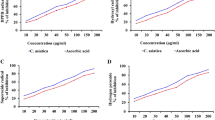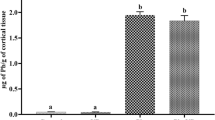Abstract
The objective of this experiment was to investigate the effects of supplemental chromium picolinate (CrPic) and chromium histidinate (CrHis) on nuclear factor-kappa B (NF-κB p65) and nuclear factor (erythroid-derived 2)-like 2 (Nrf2) signaling pathway in diabetic rat brain. Nondiabetic (n = 45) and diabetic (n = 45) male Wistar rats were either not supplemented or supplemented with CrPic or CrHis via drinking water to consume 8 μg elemental chromium (Cr) per day for 12 weeks. Diabetes was induced by streptozotocin injection (40 mg/kg i.p., for 2 weeks) and maintained by high-fat feeding (40 %). Diabetes was associated with increases in cerebral NF-κB and 4-hydroxynonenal (4-HNE) protein adducts and decreased in cerebral nuclear factor of kappa light polypeptide gene enhancer in B cells inhibitor, alpha (IκBα) and Nrf2 levels. Both Cr chelates were effective to decrease levels of NF-κB and 4-HNE protein adducts and to increase levels of IκBα and Nrf2 in the brain of diabetic rats. However, responses of these increases and decreases were more notable when Cr was supplemented as CrHis than as CrPic. In conclusion, Cr may play a protective role in cerebral antioxidant defense system in diabetic subjects via the Nrf2 pathway by reducing inflammation through NF-κB p65 inhibition. Histidinate form of Cr was superior to picolinate form of Cr in reducing NF-κB expression and increasing Nrf2 expression in the brain of diabetic rats.

Similar content being viewed by others
References
Feldman EL, Russell JW, Sullivan KA, Golovoy D (1999) New insights into the pathogenesis of diabetic neuropathy. Curr Opin Neurol 12:553–563
Biessels GJ, Kamal A, Urban IJ, Spruijt BM et al (1998) Water maze learning and hippocampal synaptic plasticity in streptozotocin diabetic rats: effects of insulin treatment. Brain Res 800:125–135
Vincent AM, Edwards JL, Sadidi M, Feldman EL (2008) The antioxidant response as a drug target in diabetic neuropathy. Curr Drug Targets 9:94–100
Kumar A, Negi G, Sharma SS (2011) JSH-23 targets nuclear factor-kappa B and reverses various deficits in experimental diabetic neuropathy: effect on neuroinflammation and antioxidant defence. Diabetes Obes Metab 13:750–758
Cameron NE, Cotter MA (2008) Pro-inflammatory mechanisms in diabetic neuropathy: focus on the nuclear factor kappa B pathway. Curr Drug Targets 9:94–100
Meunier A, Latrémolière A, Dominguez E et al (2007) Lentiviral-mediated targeted NF-kappaB blockade in dorsal spinal cord glia attenuates sciatic nerve injury-induced neuropathic pain in the rat. Mol Ther 15:687–697
Kim J, Cha YN, Surh YJ (2010) A protective role of nuclear factor-erythroid 2-related factor-2 (Nrf2) in inflammatory disorders. Mutat Res 690:12–23
Negi G, Kumar A, Joshi RP, Sharma SS (2011) Oxidative stress and Nrf2 in the pathophysiology of diabetic neuropathy: old perspective with a new angle. Biochem Biophys Res Commun 408:1–5
Yoh K, Hirayama A, Ishizaki K et al (2008) Hyperglycemia induces oxidative and nitrosative stress and increases renal functional impairment in Nrf2-deficient mice. Genes Cells 13:1159–1170
Negi G, Kumar A, Sharma SS (2011) Melatonin modulates neuroinflammation and oxidative stress in experimental diabetic neuropathy: effects on NF-kappaB and Nrf2 cascades. J Pineal Res 50:124–131
Vincent JB (2010) Chromium: celebrating 50 years as an essential element? Dalton Trans 39:3787–3794
Di Bona KR, Love S, Rhodes NR, McAdory D et al (2011) Chromium is not an essential trace element for mammals: effects of a “low-chromium” diet. J Biol Inorg Chem 16:381–390
Wallach S (1985) Clinical and biochemical aspects of chromium deficiency. J Am Coll Nutr 4:107–120
Faure P, Roussel A, Coudray C et al (1992) Zinc and insulin sensitivity. Biol Trace Elem Res 32:305–310
Becker DJ, Reul B, Ozcelikay AT et al (1996) Oral selenate improves glucose homeostasis and partly reverses abnormal expression of liver glycolytic and gluconeagenic enzymes in diabetic rats. Diabetologia 39:3–11
Sahin K, Onderci M, Tuzcu M et al (2007) Effect of chromium on carbohydrate and lipid metabolism in a rat model of type 2 diabetes mellitus: the fat-fed, streptozotocin-treated rat. Metabolism 56:1233–1240
Ding W, Chai Z, Duan P et al (1998) Serum and urine chromium concentrations in elderly diabetics. Biol Trace Elem Res 63:231–237
Cefalu WT, Wang ZQ, Zhang XH et al (2002) Oral chromium picolinate improves carbohydrate and lipid metabolism and enhances skeletal muscle Glut-4 translocation in obese, hyperinsulinemic (JCR-LA corpulent) rats. J Nutr 132:1107–1114
Anderson RA, Polansky MM, Bryden NA (2004) Stability and absorption of chromium and absorption of chromium histidinate complexes by humans. Biol Trace Elem Res 101:211–218
Häcker H, Karin M (2006) Regulation and function of IKK and IKK-related kinases. Sci STKE 2006(357):re13
Reed MJ, Meszaros K, Entes LJ (2000) A new rat model of type 2 diabetes: the fat-fed, streptozotocin-treated rat. Metabolism 49:1390–1394
Farombi EO, Shrotriya S, Na HK et al (2008) Curcumin attenuates dimethylnitrosamine-induced liver injury in rats through Nrf2-mediated induction of heme oxygenase-1. Food Chem Toxicol 46:1279–1287
SAS, User's Guide (2002) Statistics, version 9. Statistical Analysis System. SAS Inst., Inc., Cary, NC
Jain SK, Lim G (2006) Chromium chloride inhibits TNF-α and IL-6 secretion in isolated human blood monoclear cells exposed to high glucose. Horm Metab Res 38:60–62
Jain SK, Rains JL, Croad JL (2007) Effect of chromium niacinate and chromium picolinate supplementation on lipid peroxidation, TNF-a, IL-6, CRP, glycated hemoglobin, triglycerides and cholesterol levels in blood of streptozotocin-treated diabetic rats. Free Radic Biol Med 43:1124–1131
Figueroa-Romero C, Sadidi M, Feldman EL (2008) Mechanisms of disease: the oxidative stress theory of diabetic neuropathy. Rev Endocr Metab Disord 9:301–314
Acharyya S, Villalta SA, Bakkar N et al (2007) Interplay of IKK/NF-kappaB signaling in macrophages and myofibers promotes muscle degeneration in Duchenne muscular dystrophy. J Clin Invest 117:889–901
Zhang X, Zhang G, Zhang H et al (2008) Hypothalamic IKKbeta/NF-kappaB and ER stress link overnutrition to energy imbalance and obesity. Cell 135:61–73
Tuzcu M, Sahin N, Orhan C et al (2011) Impact of chromium histidinate on high fat diet induced obesity in rats. Nutr Metab (Lond) 3:8–28
Russell JW, Golovoy D, Vincent AM et al (2002) High glucose-induced oxidative stress and mitochondrial dysfunction in neurons. FASEB J 16:38–48
Sima AA, Sugimoto K (1999) Experimental diabetic neuropathy: an update. Diabetologia 42:773–788
Akude E, Zherebitskaya E, Roy Chowdhury SK et al (2010) 4-Hydroxy-2-nonenal induces mitochondrial dysfunction and aberrant axonal outgrowth in adult sensory neurons that mimics features of diabetic neuropathy. Neurotox Res 17:28–38
Ishii T, Itoh K, Ruiz E et al (2004) Role of nrf2 in the regulation of cd36 and stress protein expression in murine macrophages activation by oxidatively modified LDL and 4-hydroxynonenal. Circ Res 94:609–616
Obrosova IG, Drel VR, Pacher P et al (2005) Oxidative-nitrosative stress and poly (ADPribose) polymerase (PARP) activation in experimental diabetic neuropathy: the relation is revisited. Diabetes 54:3435–3441
Obrosova IG, Ilnytska O, Lyzogubov VV et al (2007) High-fat diet induced neuropathy of pre-diabetes and obesity: effects of “healthy” diet and aldose reductase inhibition. Diabetes 56:2598–2608
Praticò D, Tangirala RK, Rader DJ et al (1998) Vitamin E suppresses isoprostane generation in vivo and reduces atherosclerosis in Apo E-deficient mice. Nat Med 4:1189–1192
Preuss HG, Grojec PL, Lieberman S, Anderson RA (1997) Effects of different chromium compounds on blood pressure and lipid peroxidation in spontaneously hypertensive rats. Clin Nephrol 47:325–330
Acknowledgments
The authors thank Nutrition 21, Purchase, NY for providing financial support for this study.
Conflict of interest
The study was funded by Nutrition 21, Inc., NY, USA. Nutrition 21 also supplied the chromium picolinate and chromium histidinate used in the study. James R. Komorowski is an employee of Nutrition 21, the distributors of chromium picolinate under a license from the USDA.
Author information
Authors and Affiliations
Corresponding author
Rights and permissions
About this article
Cite this article
Sahin, K., Tuzcu, M., Orhan, C. et al. The Effects of Chromium Picolinate and Chromium Histidinate Administration on NF-κB and Nrf2/HO-1 Pathway in the Brain of Diabetic Rats. Biol Trace Elem Res 150, 291–296 (2012). https://doi.org/10.1007/s12011-012-9475-9
Received:
Accepted:
Published:
Issue Date:
DOI: https://doi.org/10.1007/s12011-012-9475-9




